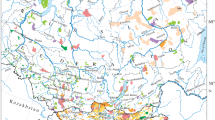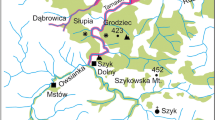Abstract
Very important initiatives have been taken and policies have been adopted in the European Union to protect areas of great importance for threatened species and habitats. Protected areas differ broadly in terms of category, natural conditions and administrative organisation, from international initiative such as Biosphere Reserves, European ones with Natura 2000 network until the institution of national and regional protected areas. In France, the administrative subdivisions known as “départements” were created with the French Revolution in the end of the eighteenth century; in 1985 an original and autonomous procedure to establish special protected areas, called “Sensitive Natural Spaces” (SNS) was devolved to them. The scope of this paper is to present an overview of these devolved powers which enable French départements to create protected areas and to levy a departmental tax on sensitive natural spaces (DTSNS). We statistically studied some parameters by multivariate methods in order to explain the choices of this policy by the départements. The huge variations in the way these powers are implemented prove the development of new environmental territories.



Similar content being viewed by others
References
Adger, W. N., Brown, K., Fairbrass, J., Jordan, A., Paavola, J., Rosendo, S., et al. (2003). Governance for sustainability: Towards a “thick” analysis of environmental decision-making. Environment & Planning A, 35, 1095–1110. doi:10.1068/a35289.
Balmford, A., Bruner, A., Cooper, P., Costanza, R., Farber, S., Green, R., et al. (2002). Economic reasons for conserving wild nature. Science, 297(5583), 950–953. doi:10.1126/science.1073947.
Bastian, C. T., McLeod, D. M., Germino, M. J., Reiners, W. A., & Blasco, B. J. (2002). Environmental amenities and agricultural land values: A Hedonic model using geographic information systems data. Ecological Economics, 40(3), 337–349. doi:10.1016/S0921-8009(01)00278-6.
Billet, P. (2006). La place des espaces naturels sensibles dans le droit de la protection des espaces naturels. Revue Juridique de l’Environnement, 2, 153–162.
Bockstael, N. E., & Irwin, E. G. (2000). Economics and land use-environment link. In T. Tietenberg & H. Folmer (Eds.), International yearbook of environmental and resource economics 2000/2001 (pp. 9–37). Cheltenham, UK: Edward Elgar.
Bouin, F. (2006). Les conditions d’ouverture au public dans les espaces naturels. Revue Juridique de l’Environnement, 2, 171–176.
Bussi, M., & Badariotti, D. (2004). Pour une nouvelle géographie du politique Territoire-Démocratie-Elections (p. 301). Paris: Anthropos.
Calleo, D. P. (2001). Rethinking Europe’s future (p. 283). Princeton: Princeton University Press.
Cheshire, P., & Sheppard, S. (1995). On the price of land and the value of amenities. Economica, 6, 247–267. doi:10.2307/2554906.
Commission of the European Communities. (2001). European Governance. A white paper. 25.07.2001.COM (2001) 428 final (p. 35). Brussels: Office for Official Publications of the European Communities.
Costanza, R., D’Arge, R., De Groot, R., Farber, S., Grasso, M., Hannon, B., et al. (1997). The value of the world’s ecosystem services and natural capital. Nature, 387, 253–260. doi:10.1038/387253a0.
Delivre-Gilg, C. (2006). La taxe départementale des espaces naturels sensibles. Revue Juridique d’Environnement, 2, 139–152.
Delreux, T. (2006). The European Union in international environmental negotiations: A legal perspective on the internal decision-making process. International Environmental Agreements, 6, 231–248. doi:10.1007/s10784-006-9015-1.
Drobenko, B. (2006). Le droit de préemption des espaces naturels sensibles comme technique de maitrise foncière environnementale. Revue Juridique de l’Environnement, 2, 125–138.
Durousseau, M. (2006). Quelle gouvernance pour les espaces naturels sensibles des départements? Revue Juridique de l’Environnement, 2, 177–184.
European Commission. (2002). A European Union strategy for sustainable development—COM (2001) 264 final (p. 72). Luxembourg: Office for Official Publications of the European Communities.
Fall, J. (2004). Divide and rule: Constructing human boundaries in ‘boundless nature’. GeoJournal, 58, 243–251. doi:10.1023/B:GEJO.0000017955.72829.15.
Fevrier, J. M. (2006). Les espaces naturels sensibles des départements et la gestion des sites Natura 2000. Revue Juridique de l’Environnement, 2, 171–176.
Fisch, R., Seymour, S., & Watkines, C. (2003). Conserving English landscapes: Land managers and agri-environmental policy. Environment & Planning A, 35, 19–41. doi:10.1068/a3531.
Freeman, A. M. (1993). The measurement of environmental and resource values. Washington, DC: Resources for the future.
Frois, P. (1998). Développement durable dans l’Union Européenne (p. 185). Paris: L’Harmattan.
Geoghegan, J., Wainger, L. A., & Bockstael, N. E. (1997). Spatial landscape indices in a Hedonic framework: An ecological economics analysis using GIS. Ecological Economics, 23(3), 251–264. doi:10.1016/S0921-8009(97)00583-1.
Girault, F. (2002). L’exception territoriale française sous influence européenne? L’Information Geographique, 2, 133–161.
Hardt, L., & Walter, R. (1993). Das Europa der Regionen (pp. 34–39). Frankfurt/Main: Werk und Zeit.
Hergenhan, J. (2001). Governance in the European Union after Nice. Eurocities, 13, 4.
IFEN. (2002). L’environnement en France (p. 606). Paris: Institut Français de l’Environnement, La Découverte.
Irwin, E. G., & Bockstael, N. E. (2004). Land use externalities, open space preservation, and urban sprawl. Regional Science and Urban Economics, 34, 705–725. doi:10.1016/j.regsciurbeco.2004.03.002.
Jupille, J., & Caporaso, J. (1998). States, agency, and rules: The European Union in global environmental politics. In C. Rhodes (Ed.), The European Union in the world community (pp. 213–229). London: Lynne Rienner Publishers.
Lajarge, R. (2002). Territoires au pluriel: Projets et acteurs en recomposition. L’Information Geographique, 2, 113–132.
Laurent, L. (2002). La fin des départements (p. 151). Rennes: Presses de l’Université de Rennes.
Lenclos, J. L. (1997). La taxe départementale des espaces naturels sensibles. Revue Juridique de l’Environnement, 2, 189–198.
Locantore, N. W., Tran, L. T., O’Neill, R. V., McKinnis, P. W., Smith, E. R., & O’Connell, R. V. (2004). An overview of data integration methods for regional assessment. Environmental Monitoring and Assessment, 94, 249–261. doi:10.1023/B:EMAS.0000016892.67527.4c.
Loreau, M. (2000). Biodiversity and ecosystem functioning: Recent theoretical advances. Oikos, 91, 3–17. doi:10.1034/j.1600-0706.2000.910101.x.
Merlin, P. (2002). L’aménagement du territoire (p. 448). Paris: Presses Universitaires de France.
Morand-Deviller, J. (1996). Droit de l’environnement (p. 194). Paris: ESTEM.
Moulaert, F., & Sekia, F. (2003). Territorial innovation models: A critical survey. Regional Studies, 37(3), 289–302. doi:10.1080/0034340032000065442.
Myers, N., Mittermeier, R. A., Mittermeier, C. G., Da Fonseca, G. A. B., & Kent, J. (2000). Biodiversity hotspots for conservation priorities. Nature, 403, 853–858. doi:10.1038/35002501.
Offner, J.-M. (2006). Les territoires de l’action publique locale. Revue Francaise de Science Politique, 56(1), 27–48.
Ozouf-Marinier, M.-V. (1986). Politique et géographie lors de la création des départements français (1789–1790). Hérodote, 40(1), 140–160.
Périnet-Marquet, H. (1997). Le droit de préemption dans les espaces naturels sensibles. Revue Juridique de l’Environnement, 2, 173–182.
Piercy, P. (1997). La France, le fait régional (p. 287). Paris: Hachette.
Pinton, F., Alphandery, P., Billaud, J.-P., Deverre, C., & Fortier, A. (2007). La construction du réseau Natura 2000 en France (p. 254). Paris: La Documentation Française IFB.
Poli-Broc, A. (2003). Guide pratique du droit de l’environnement (p. 328). Paris: Berger-Levrault.
Pratts, M., & Rimkine, P. (1997). Évaluation des politiques des espaces naturels sensibles menés par les départements. Paris: unpublished report, p. 80.
Prazan, J., Ratinger, T., & Krumalova, V. (2005). The evolution of nature conservation policy in the Czech Republic—challenges of Europeanization in the White Carpathians Protected Landscape Area. Land Use Policy, 22(3), 235–243. doi:10.1016/j.landusepol.2003.09.010.
Prieur, M. (1997). Les mesures complémentaires de protection des espaces naturels sensibles. Revue Juridique de l’Environnement, 2, 183–187.
Prieur, M. (2001). Droit de l’environnement (p. 775). Paris: Dalloz.
Prieur, M. (2006). Quel avenir pour les espaces naturels sensibles? Revue Juridique de l’Environnement, 2, 185–192.
Pröbstl, U. (2003). NATURA 2000—The influence of the European directives on the development of nature-based sport and outdoor recreation in mountain areas. Journal for Nature Conservation, 11(4), 340–345. doi:10.1078/1617-1381-00066.
Romi, R. (1998). Les collectivités locales et l’environnement (p. 149). Paris: LGDJ.
Ruegg, J. (1997). Dans quelle mesure le management territorial peut-il contribuer à la gestion de l’environnement? Revue de Geographie Alpine, 2, 145–156. doi:10.3406/rga.1997.3917.
Soja, E. (1996). Thirdspace: Journeys to Los Angeles and other real-and-imagined places (p. 334). Malden: Blackwell Publishers.
Sureau, C. (2002). Espaces naturels sensibles des Côtes-d’Armor, bilan et enjeux d’une politique départementale. Unpublished Master thesis, Université Paris 8-IFU, Paris, p. 174.
Tran, L. T., Knight, C. G., O’Neill, R. V., & Smith, E. R. (2004). Integrated environmental assessment of the mid-Atlantic region with analytical network process. Environmental Monitoring and Assessment, 94, 263–277. doi:10.1023/B:EMAS.0000016893.77348.67.
Vanier, M. (2002). Recomposition territoriale. L’Information Geographique, 2, 99–112.
Vanier, M. (2003). Le périurbain à l’heure du crapaud buffle: Tiers espace de la nature, nature du tiers espace. Revue de Geographie Alpine, 4, 79–89. doi:10.3406/rga.2003.2264.
Acknowledgements
We would like to thank Rosalind Greenstein, Senior lecturer in English, Université Paris 1 Panthéon-Sorbonne, for her contribution and Professor Marie Cottrel, Professor of Mathematics, University Paris 1 Panthéon-Sorbonne, for very useful assistance in statistical analysis.
Author information
Authors and Affiliations
Corresponding author
Rights and permissions
About this article
Cite this article
Pierre, P., Sophie, D., Anne-Gabrielle, G. et al. Environmental conservation and the production of new territories: the example of French départements . GeoJournal 75, 149–161 (2010). https://doi.org/10.1007/s10708-009-9259-8
Received:
Accepted:
Published:
Issue Date:
DOI: https://doi.org/10.1007/s10708-009-9259-8




